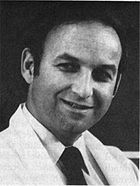
Summary
Robert Martin Boyar (March 10, 1937, New York – November 27, 1978, Dallas, Texas) was a physician and endocrinologist known for his studies of the neuroendocrinology of puberty.
Robert M. Boyar | |
|---|---|
 Robert M. Boyar | |
| Born | March 10, 1937 |
| Died | November 27, 1978 (aged 41) |
| Nationality | American |
| Occupation(s) | physician, endocrinologist |
| Known for | neuroendocrine studies of puberty |
Early years and education edit
Boyar received his MD from Albert Einstein College of Medicine, Bronx, New York, 1962. He was a Navy physician during the Vietnam War, and on the medical staff of Montefiore Medical Center. For 2½ years he was Associate Professor of Internal Medicine, University of Texas Southwestern Medical School, Dallas.
Scientific discoveries edit
Boyar is best known for his studies of gonadotropin secretion in puberty. An American physiologist, Ernst Knobil, discovered that the anterior pituitary produces pulses of Luteinizing hormone at about hourly intervals. The luteinizing hormone pulses are the consequence of pulsatile gonadotropin releasing hormone secretion by the hypothalamus into the pituitary portal circulation that, in turn, is the result of an oscillator or signal generator in the central nervous system (the "gonadotropin releasing hormone pulse generator").[1] Boyar demonstrated that in children approaching puberty the Luteinizing Hormone pulses occur only during sleep.[2] This sleep related gonadotropin secretion initiates testosterone secretion in boys and estradiol secretion in girls, which ultimately result in the clinical characteristics associated with human puberty.[3] Some investigators have attributed the onset of puberty to a resonance of oscillators in the brain.[4][5][6] By this mechanism, the gonadotropin pulses that occur during sleep in puberty represent beats.[7][8][9]
References edit
- ^ Neill, JD (2001). "In memoriam: Ernst Knobil (1926-2000)". Endocrine Reviews. 22 (6): 721–3. doi:10.1210/edrv.22.6.8566. PMID 11739328.
- ^ Boyar, R; Finkelstein, J; Roffwarg, H; Kapen, S; Weitzman, E; Hellman, L (1972). "Synchronization of augmented luteinizing hormone secretion with sleep during puberty". The New England Journal of Medicine. 287 (12): 582–6. doi:10.1056/NEJM197209212871203. PMID 4341276.
- ^ Boyar, RM; Rosenfeld, RS; Kapen, S; Finkelstein, JW; Roffwarg, HP; Weitzman, ED; Hellman, L (1974). "Human Puberty Simultaneous Augmented Secretion of Luteinizing Hormone and Testosterone During Sleep". The Journal of Clinical Investigation. 54 (3): 609–18. doi:10.1172/JCI107798. PMC 301594. PMID 4852310.
- ^ Sizonenko, PC; Aubert, ML (1986). "Neuroendocrine changes characteristic of sexual maturation". Journal of Neural Transmission. Supplementum. 21: 159–81. PMID 3462329.
- ^ Rivest, RW (1991). "Sexual maturation in female rats: hereditary, developmental and environmental aspects". Experientia. 47 (10): 1027–38. doi:10.1007/bf01923338. PMID 1936201. S2CID 28120306.
- ^ Yellon, SM; Newman, SW (1991). "A developmental study of the gonadotropin-releasing hormone neuronal system during sexual maturation in the male Djungarian hamster". Biology of Reproduction. 45 (3): 440–6. doi:10.1095/biolreprod45.3.440. PMID 1782292.
- ^ Lehrer, S (1983). "Puberty and resonance: a hypothesis" (PDF). The Mount Sinai Journal of Medicine, New York. 50 (1): 39–43. PMID 6601758.
- ^ Lehrer, S (1986). "Rats on 22.5-hr light:dark cycles have vaginal opening earlier than rats on 26-hr light:dark cycles". Journal of Pineal Research. 3 (4): 375–8. doi:10.1111/j.1600-079X.1986.tb00759.x. PMID 3783418. S2CID 41436917.
- ^ Lehrer S (2015). "Continuation of gradual weight gain necessary for the onset of puberty may be responsible for obesity later in life". Discovery Medicine. 110 (110): 191–196. PMC 4809356. PMID 26562472.
Bibliography edit
- Sizonenko, PC. Role of sex steroids during development—integration. in Bourguignon, Jean Pierre & Tony M. Plant. The Onset of Puberty in Perspective: Proceedings of the 5th International Conference on the Control of the Onset of Puberty, Held in Liège, Belgium, 26–28 September 1999. Elsevier. Amsterdam & New York 2000. ISBN 0-444-50296-3 pp 299–306. [1]
- Vilaplana, J; Madrid, JA; Sánchez-Vázquez, J; Campuzano, A; Cambras, T; Díez-Noguera, A (1995). "Influence of period length of light/dark cycles on the body weight and food intake of young rats". Physiology & Behavior. 58 (1): 9–13. doi:10.1016/0031-9384(95)00021-A. PMID 7667433. S2CID 43118869.


